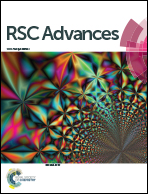Effect of the length of the alkyl chains in porphyrin meso-substituents on the performance of dye-sensitized solar cells†
Abstract
A series of novel zinc porphyrin dyes which have a D–π–A structure have been designed and synthesized for DSSC applications. The donors containing a carbazole group in which the carbazole nitrogen is bonded with a butyl, hexyl or decyl chain, had a significant influence on the spectra of the TiO2 films and the electrochemical and photovoltaic properties of these sensitizers. The sensitizer with a hexyl chain (CZ-6) achieved a higher overall conversion efficiency than that with a butyl chain (CZ-4) because of its slower charge recombination rate and faster electron injection from the dye to the conduction band of the conducting glass. Furthermore, the dye with a decyl chain (CZ-10) performed the lowest conversion efficiency, resulting from the least amount of dye loading. This was due to the steric hindrance of the molecule. The highest light-to-electricity conversion efficiency (η) of 2.13% was realized for the dye CZ-6 based DSSC, which was higher than those achieved for the CZ-4- and CZ-6-sensitized DSSCs (1.69% and 1.30% respectively).


 Please wait while we load your content...
Please wait while we load your content...